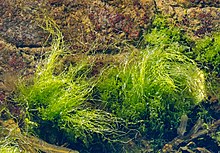en
names in breadcrumbs


Ulva is a genus of green algae known commonly as sea lettuce or green laver. Ulva seaweeds are found worldwide in nitrogen-rich marine habitats attached to rocks in the mid to low intertidal zone (Lee 2008; Kirby 2001). The fronds of Ulva usually grow as sheets, but some species exist in a hollow cylindrical form. These cylindrical species were previously classified as a distinct genus, Enteromorpha, but are now included in Ulva. (Lee 2008; Hayden et al 2003). The blades can grow up to 40 cm long, but are very thin—only 2 cells thick (Lee 2008).
Ulva is eaten by humans in soups, salads, and sushi (Lee 2008 and references within; Kirby 2001).
Ulva is found worldwide.
Lives in marine environments, and sometimes found in brackish waters in estuaries, however, Ulva needs nitrogen-rich waters. Ulva attaches to rocks in the mid to low intertidal zone (Lee 2008; Kirby 2001).
Ulva goes through an isomorphic alternation of generations. Adult gametophytes produce only female or male gamets, which are positively phototactic, and move with flagella. They are released in swarms coordinated by lunar cycles and tides. When the zygote is formed it becomes negatively phototactic and swims to the bottom to settle, and germinates within a few days. The haploid phase of the life cycle (the sporophyte), produces sporophytes which, like the gametes, are also motile using a set of four flagella to swim (Lee 2008; Guiry and Guiry 2011).
The fronds of Ulva usually grow as sheets, but some species exist in a hollow cylindrical form. These cylindrical species were previously classified as a distinct genus, Enteromorpha, but have been synonymized with Ulva. The blade morphology of Ulva is dependent on bacterial composition in the environment (Lee 2008; Hayden et al 2003).
Ulva is considered the main component of "green tide" events in bays especially near large cities in Japan and elsewhere. Its prolific growth becomes a nuisance, especially in run-off waters containing high nutrient levels. In these environments it can outcompete other organisms and reduce diversity in benthic communities. It also creates a nuisance on beaches when it is washed up and decomposes in large amounts as the rotting algae produces hydrogen sulfide gas (Lee 2008; Yabe 2009).
The blades can grow up to 40 cm long, but are very thin - only 2 cells thick (Lee 2008).
Ulva is eaten by humans, although the literature has some disagreement about how tasty and digestible it is. It is eaten in soups, salads and sushi (Lee 2008 and references within; Kirby 2001).
The sea lettuces comprise the genus Ulva, a group of edible green algae that is widely distributed along the coasts of the world's oceans. The type species within the genus Ulva is Ulva lactuca, lactuca being Latin for "lettuce". The genus also includes the species previously classified under the genus Enteromorpha,[1] the former members of which are known under the common name green nori.[2]
Individual blades of Ulva can grow to be more than 400 mm (16 in) in size, but this occurs only when the plants are growing in sheltered areas. A macroscopic alga which is light to dark green in colour, it is attached by disc holdfast. Their structure is a leaflike flattened thallus.[3][4]
Sea lettuce is eaten by a number of different sea animals, including manatees and the sea slugs known as sea hares. Many species of sea lettuce are a food source for humans in Scandinavia, Great Britain, Ireland, China, and Japan (where this food is known as aosa). Sea lettuce as a food for humans is eaten raw in salads and cooked in soups. It is high in protein, soluble dietary fiber, and a variety of vitamins and minerals, especially iron.[5] However, contamination with toxic heavy metals at certain sites where it can be collected makes it dangerous for human consumption.[5]
Sea lettuce species are commonly found in the saltwater aquarium trade, where the plants are valued for their high nutrient uptake and edibility. Many reef aquarium keepers use sea lettuce species in refugia or grow it as a food source for herbivorous fish. Sea lettuce is very easy to keep, tolerating a wide range of lighting and temperature conditions. In the refugium, sea lettuce can be attached to live rock or another surface, or simply left to drift in the water.
In August 2009, unprecedented amounts of these algae washed up on the beaches of Brittany, France, causing a major public health scare as it decomposed. The rotting leaves produced large quantities of hydrogen sulfide, a toxic gas. In one incident near Saint-Michel-en-Grève, a horse rider lost consciousness and his horse died after breathing the seaweed fumes; in another, a lorry driver driving a load of decomposing sea lettuce passed out, crashed, and died, with toxic fumes claimed to be the cause.[6] Environmentalists blamed the phenomenon on excessive nitrogenous compounds washed out to sea from improper disposal of pig and poultry animal waste from industrial farms.
Species in the genus Ulva include:[7]
A newly discovered Indian endemic species of Ulva with tubular thallus indistinguishable from Ulva intestinalis has been formally established in 2014 as Ulva paschima Bast.[8] Ten new species have been discovered in New Caledonia: Ulva arbuscula, Ulva planiramosa, Ulva batuffolosa, Ulva tentaculosa, Ulva finissima, Ulva pluriramosa, Ulva scolopendra and Ulva spumosa. [9]
nissima,
 Ulva intestinalis
Ulva intestinalis The sea lettuces comprise the genus Ulva, a group of edible green algae that is widely distributed along the coasts of the world's oceans. The type species within the genus Ulva is Ulva lactuca, lactuca being Latin for "lettuce". The genus also includes the species previously classified under the genus Enteromorpha, the former members of which are known under the common name green nori.